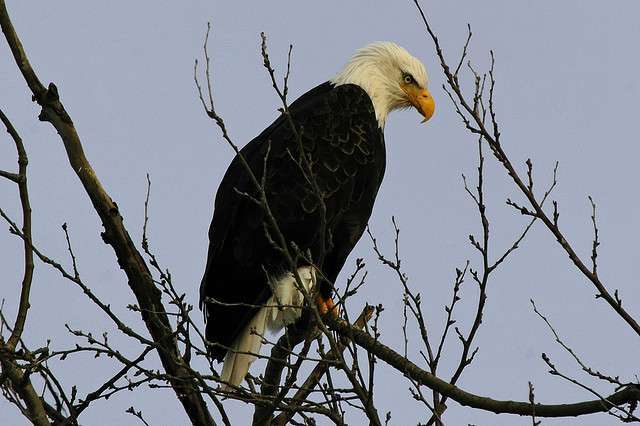On June 20, 1872 the Great Seal of the United States was adopted, sporting the bald eagle at its center, and for the past 150 years the bald eagle has served as the living symbol of freedom, courage, strength, spirit, independence and excellence, all the things America stands for. June 20, was proclaimed nationwide American Eagle Day as a way to celebrate the bald eagle, Americas living symbol of freedom and to bring attention to its dramatic recovery from the brink of extinction. In honor of that, here are some bald eagle facts and trivia.
In the early 1960’s the bald eagle population in the lower 48 states had dropped to less than 500 nesting pairs, and in 1967 they were classified as endangered. In 1995, bald eagles were moved up to a list of threatened species, and today, thanks to conservation efforts there are estimated to be nearly 138,000 bald eagles in those same 48 states. Kansas Dept of Wildlife and Parks, (KDWP) estimates there to be 137 nesting pairs here in Kansas, and several thousand bald eagles spend time in Kansas each winter. The best time to view bald eagles in Kansas is from November through February, and the best viewing is near any of our large lakes and reservoirs and anywhere along the rivers.
Bald eagles often build nests 50 feet or more off the ground. Nests are not particularly pretty, resembling a haphazard pile of sticks. The same pair uses the same nest year after year, making them larger each time, and after several years a bald eagle nest can easily be the size of a small room. The largest eagle nest ever recorded was in Florida and measured 9 ½ feet across, was 20 feet high from top-to-bottom and weighed an estimated 4500 pounds. A female bald eagle lays from 1 to 3 pure white eggs once per year in the spring. When I still lived in Ohio there were numerous active eagle nests along Lake Erie, and a game warden friend of mine was in charge of overseeing those nests. He had hours of amazing video of them checking the nests and the chicks in them each spring. They did it by helicopter using 3 people; the pilot, a second person who was lowered from the helicopter down into each nest and a third person as a lookout, constantly watching the sky for the adult eagles to prevent them from flying into the helicopter blades, killing the eagle and crashing the helicopter in the process.
The majority of the bald eagle’s diet is fish and waterfowl, so when things freeze solid in the winter up north, the eagles migrate south to find open water where they can still fish. Even when our Kansas reservoirs freeze over, the rivers feeding each reservoir still offer open water. Kansas ice fishermen often leave a few carp or other rough fish on the ice for the eagles. The huge influx of waterfowl through Kansas each winter is also a big draw to eagles. From their vantage point 1,000 or more feet above the ground an eagle’s miraculous eyes can spot prey over a 3 square mile area.
Sadly, it seems American Eagle Day gets very little publicity. At a time such as this, with all the negativity about our country, all the internal division and all the other insane and Godless things the USA celebrates, there would seem to be no better time than now to find something to bring us together as Americans. So, on June 20,th take a little time to celebrate the tenacity of our national symbol the bald eagle, and to ask God to come back into our lives and to occupy the place He deserves here in what is still the best country in the world.
Steve can be contacted by email at [email protected].
American Eagle Day
Exploring Kansas Outdoors





